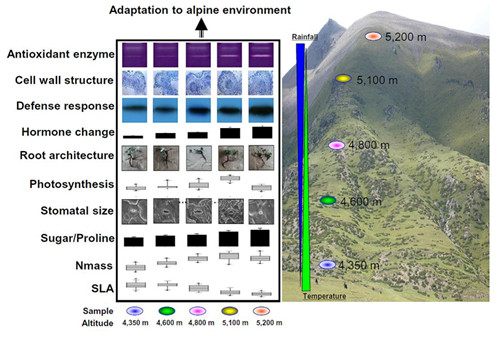The altitude gradient limits the growth and distribution of alpine plants. Multiple environmental stresses along the altitude gradient, including sharp temperature shifts, strong ultraviolet radiation exposure, and low oxygen content, are implicated in this phenomenon. Alpine plants have developed special strategies to survive the chilling environment in high mountains, but the mechanism underlying the evolution remains undefined. The alpine plant Potentilla saundersiana is widespread in the Northwestern Tibet Plateau.
Under the supervision of Profs. YANG Yongping, and HU Xiangyang at Kunming Institute of Botany, Ph. D. student MA Lan used comparative proteome analyses to investigate the dynamic protein pattern for P. saundersiana located at five different altitudes. A total of 118 differentially expressed proteins were successfully detected and functionally characterized. The proteins were members of various functional categories, including material and energy metabolism, antioxidant enzymes, defense response, protein degradation, cell wall synthesis, and hormone signal transduction. This study confirmed that increasing levels of antioxidant proteins, and their respective activities, and accumulation of primary metabolites, such as proline and sugar, confer P. saundersiana tolerance to the alpine environment. The proteins associated with the epigenetic regulation of DNA stability and post-translational protein degradation was also involved in this process. The results also showed that P. saundersiana modulated root architecture and leaf phenotype to enhance adaptation to alpine environmental stress through hormone synthesis and signal transduction, particularly the cross-talk of auxin and strictosidine. Based on these findings, The researchers conclude that P. saundersiana uses multiple strategies to adapt to the high-altitude environment in the Tibet plateau.
This work was supported by the Young Academic and Technical Leader Raising Foundation of Yunnan Province (No.2012HB041), the National Natural Sciences Foundation of China (No. 31170256 ), and the Major State Basic Research Development Program (2010CB951700). This manuscript entitled “Physiological, biochemical and proteomics analysis reveals the adaptation strategies of the alpine plant Potentilla saundersiana at altitude gradient of the Northwestern Tibetan Plateau” was published on

Schematic illustration of a proposed model for P. saundersiana adaptation to alpine environmental stress along the altitude gradient.




